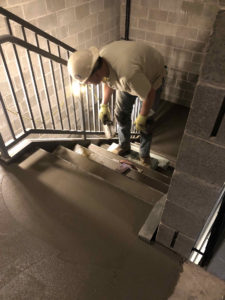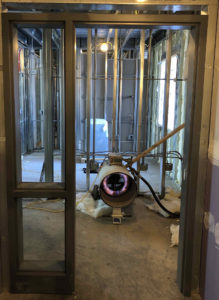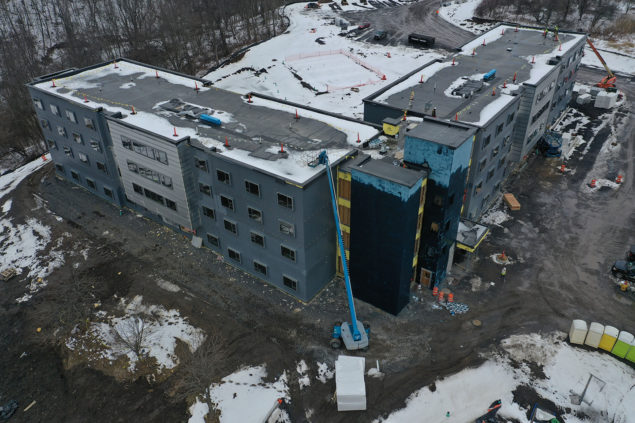News & Insights
Passive House - It's More Affordable Than You Think
February 16, 2021
First, the Norm
Typically in the winter, a construction site for a project like this (a four-story residence hall, about 20,000 SF per floor), will utilize at least one torpedo heater at the center of each floor, if not two, and large blower fans pushing the heat throughout the building. This is done to keep the inside temperature of the building above 50 degrees to avoid drywall cracking and allow the contractors to continue work in cold weather.Until this net-zero project, I’ve never been able to walk through one of these buildings in the winter without seeing my breath and seeing most workers wearing coats, hats, and sometimes gloves. So it came as a great surprise at this site visit to see only one torpedo heater on the bottom floor of the building heating the entire building. What was even more shocking than not seeing my breath was that even on the fourth floor workers were wearing t-shirts. This was before the building was entirely finished and airtight! Imagine what this would do to your heating and cooling bills once the building is complete.


Workers in building with one heater and subzero temperatures outside.
This story perfectly illustrates that by designing and constructing to Passive House standards, building owners can expect to save 90-95% on heating and 60-70% on cooling bills. In addition, occupants will be healthier and more comfortable due to less outside air infiltration, drafts, and more comfortable, consistent temperatures along outside walls. Construction costs alone for a project this size would normally budget $100,000 for temporary heating in the winter, now reduce that by 90% just for construction energy costs alone.
So what about those added construction costs, surely there has to be a cost and magic formula to create these savings, right? It has to be complicated to achieve something so ambitious…
If you have a knowledgeable design team, it’s surprisingly easier than you would think to develop a Passive House building, as we demonstrated in designing a net-zero energy ready building. We found that the energy savings associated with designing to passive house standards are the most economical path to provide net-zero energy results. By focusing on reducing the biggest energy usage in the building; heating & cooling, we were able to achieve the majority of our energy savings in a cost effective manner. The remaining amount of energy savings came from fairly expensive measures, such as utilizing heat recovery on the shower drains, which result in a fraction of a percentage of the energy savings.
Passive House & Cost Impact
The five major principles of Passive House are super-insulation, high-quality windows, elimination of thermal bridging, an air tight building envelope, and heat recovery. It is our experience that three of these principles have a significant return on investment for energy savings, and really should be used in conjunction with each other to best benefit from their use.Exterior Insulation
Exterior insulation, in the case of our project in central New York, was double the typical R-value. Getting to such a high R-value isn’t quite as simple as doubling the cost of your insulation, but it’s a good start for early budgeting purposes. However, evaluation of how the building needs to adjust to accommodate the extra insulation should be considered as this can impact that budgetary number. If it’s entirely inside of the building envelope, the exterior wall cavities likely need to get thicker; you may have to use deeper stud walls and lose usable space inside. If it’s outside of the envelope, care must be taken with applicable codes that limit what materials can be used for both the insulation, and the cladding, depending on what is being used as a base design. Selection of insulating materials (which may be more expensive) can also help reduce the extra space required.

Building exterior during construction displaying R-40 exterior wall insulation.
Windows and Glazing
For budgeting purposes, a simple change to triple pane glazing in curtainwall, or European style windows (for punched openings) is necessary. Traditional storefront and residential windows (double hung, sliders, casement) simply don’t have the thermal properties required to meet the thermal break requirements.
Structural Thermal Breaks
Putting all of the effort into increased insulation and glazing won’t pay off if all of that heat was drained through a few structural elements. Think of structural thermal breaks like a straw; warm air from inside of your building can travel right through the tube of the straw to the outside of your building, wasting all of that heat. By cutting the straw in half, all of that warm air (and your money) can’t be sucked out of the building. This means that a structural thermal break material needs to occur anywhere that the building structure penetrates the building envelope. For any project, this will include special construction at the foundation walls, along with any structural elements that extend beyond the building, such as a balcony, building overhang, or roof canopy.
So What's Next?
Passive House, or some form of its principles, can and should be a realistic goal for your project from a budgeting perspective. For this practice to be successful, other details like the orientation of the building, or ensuring continuous and properly installed air and vapor barriers are critical. These details should not add to construction costs. They should be standard practice on all construction projects. The first step is finding a knowledgeable design team that is willing to walk you through the process and explain things to you.
Hilltop Lall at SUNY Polytechnic Utica is the first residence hall in the SUNY system to be designed as a net-zero energy ready building. The building has also achieved net-zero carbon status.
As the project manager for WTW and project architect, I’m fortunate to have led the design team at WTW along with our local design team of HKK Architects out of Syracuse, IPD Engineering, edr landscape architect, and sustainability consultant GMB. Our design-build contractor, Hueber Breuer Construction, put together a great team for this ambitious vision set forth by DASNY and the SUNY system.
Previous Post
January 18, 2021
Next Post
April 14, 2021